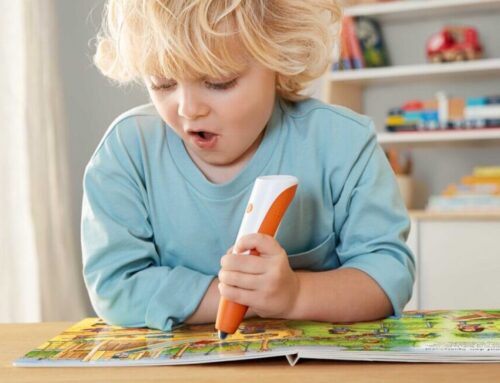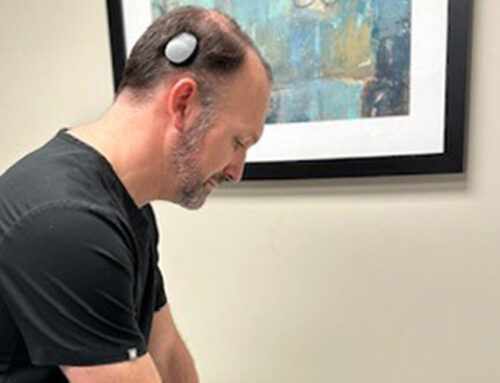Intergenerational CI hearing training with the Toniebox
Johann Reithmayer uses his grandchildren’s toys for hearing training. His youngest grandson and his mother came up with the idea – and the whole family got involved.
Eva Kohl
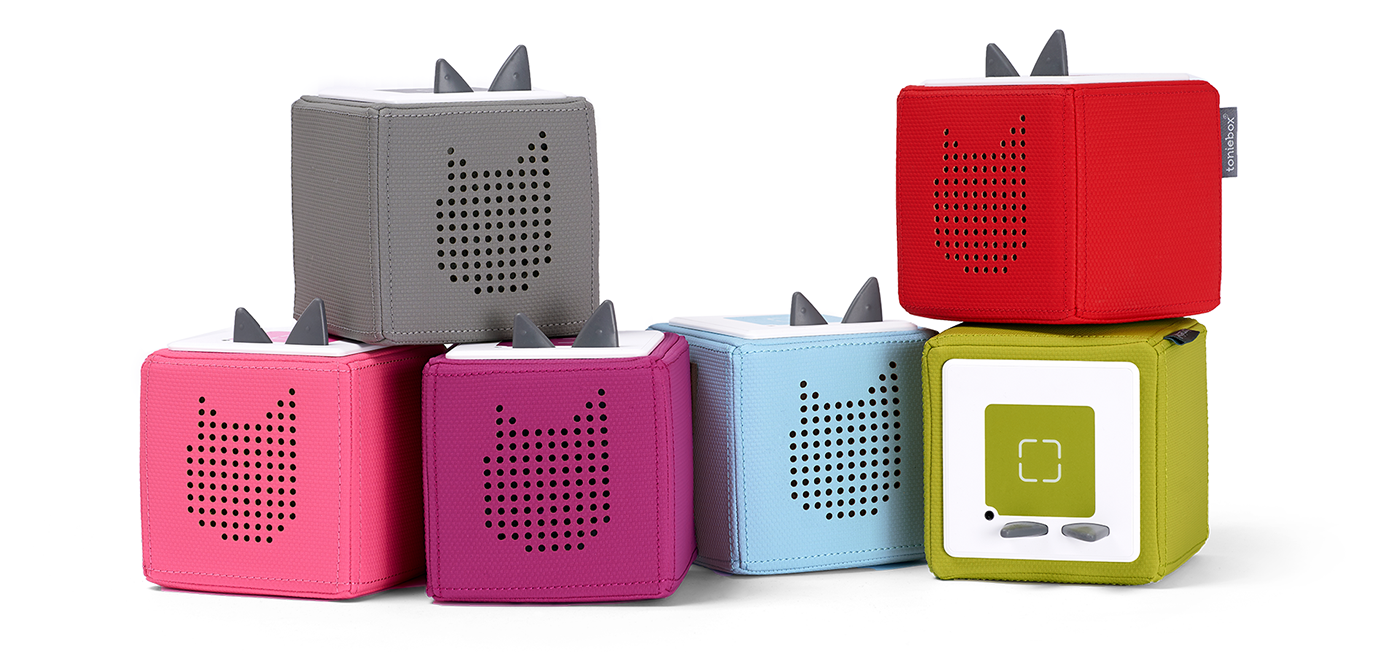
The Reithmayer family lives in the Waldviertel, just 400 meters above what is perhaps the most romantic stretch of the Danube. Three generations under one roof: the grandparents on the ground floor, one of the daughters with her husband and two children on the first floor. Separate living units, separate entrances, but lots of time together eating, chatting and playing with the grandchildren. When nine-year-old Lukas and his six-year-old brother Emil want to listen to a bedtime story after a long day, they come down to their grandparents one last time before going to bed: "Grandpa, we're going to get the Toniebox. But we'll bring it back to you in the morning, I promise!" Because during the day, Grandpa Johann Reithmayer uses his grandchildren's Toniebox for his listening exercises.
The idea came after a discovery made by five-year-old Emil in September 2022. The senior Reithmayer had just been implanted with a CI and had just received his audio processor and all its accessories. He tried everything out at home. "I had just plugged the AudioLink into my cell phone when the little boy came into the room." He watched the scene for a moment. Then he disappeared and reappeared with his Toniebox under his arm: "Grandpa, you can plug it in there too, he said!", pointing to the audio socket on his Toniebox.
The cassette recorder was only yesterday...
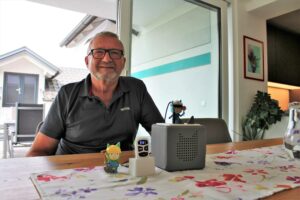
During the day, the boys Lukas and Emil lend their Toniebox to their grandpa to practise with his new cochlear implant. ©Eva Kohl
According to the manufacturer, the Toniebox is designed for children aged three and over. It takes over the function that the cassette recorder had in the second half of the 20th century: playing and recording audio sources. However, the box itself only serves as a playback device. Instead of the cassette of earlier days, the sound carrier is now a small plastic figure called Tonie. These are simply placed on the box for playback. Around 700 different Tonies - also in different languages - are available in toy and electronics stores as well as directly from the manufacturer: with children's songs, audio stories and even factual information for children.
If parents want to record their children's favorite fairy tales themselves - or if the children want to record their singing skills - they need so-called creative Tonies and a conventional smartphone. The latter serves as a recording device. The recording is then transferred from the smartphone to the Kreativ-Tonie using a special app. Less creative families can also load the Kreativ-Tonie from an online audio library: one of over 600 free titles or a further 3,000 available for purchase. Over five million Tonieboxes have been sold internationally since the market launch in 2016. The average user listens to their Tonies for almost four and a half hours a week. The success story of a German product that conquered children's rooms.
The possibility of using the Toniebox for listening therapy was developed by the Reithmayer family in Lower Austria. Weekly use is probably only just below average.
Hearing training as a family project
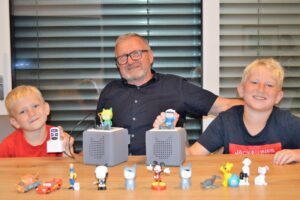
"Grandpa, you can put that on there too!" ©Bernadette Pehmer
"Paper, house, cell phone, ballaballa, ...", a bright child's voice sounds from the Toniebox, followed a little later by a slightly lower voice: "Lady's pear, cat's branch, flute garden, ..." The suggestion to also practice with nonsense words came from Bianca Wirthner MSc. She is a music therapist at the St. Pölten University Hospital, where Johann Reithmayer also attended hearing therapy after his implantation. There he was given the task of practicing regularly at home: ideally with a playback device that transmits the practice words directly to the implant's audio processor. Over a meal together, the family thought about which device would be suitable. Daughter Bernadette - mother of Emil and Lukas - remembered her sons' Toniebox. They could record the practice words on one of the Kreativ-Tonies.
In the end, the whole family was involved in the auditory training project: Daughter Bernadette made long lists of number and color words, one- and two-syllable words and, finally, said meaningless, compound words. Each family member read one of these lists on their cell phone. Even little Emil wanted to help. As he couldn't read yet as a kindergarten child, he simply said the words that came to his mind during the recordings. The mother of the two Toniebox owners transferred the recordings from her smartphone to a Kreativ-Tonie. With the Tonie attached and the AudioLink plugged in for transmission to the audio processor, the Toniebox became a training device for Johann Reitmayer, who was still inexperienced with CI at the time.
Speech, music, birds - and even hearing the tennis ball
"In the beginning, we recorded every word three times in a row," says wife Melitta Reithmayer. Understanding was still difficult: in the transcript there are almost only dashes for "nothing understood". Later, there were more and more ticks for words that were understood. "Elias, Emil, Eliana, ...", come the last recorded word sequences in almost uninterrupted succession from the creative tone. All the names of close family members; 17 in total. "During the conversation, the other person keeps talking. You don't have time to think about it: you either understand it or you don't," explains Johann Reitmayer with conviction. His wife smiles: "With Michael, my husband understood Michelle for a long time..." You can move from one word list to the next by tapping on the side of the Toniebox. Only the order of the practice words within the lists cannot be varied. This was only possible last time, when practicing without the Toniebox - with live voice over the phone.
The sibilants were particularly difficult for the man in his mid-sixties: "I hadn't heard the high-pitched sounds for 30 years before the CI." He then worked specifically on these deficits during his rehabilitation stay in Bad Nauheim in Germany. This not only improved his speech comprehension: "Music also sounds much fuller now, rounder!" That was a long time ago. "Now the noise is no longer so intense," he admits and is pleased: "I can now even hear when I'm serving a tennis ball whether it's going to be sharp or not." Now, a year after his implantation, he is considering whether a CI in the other ear would also be better than the conventional hearing aid.
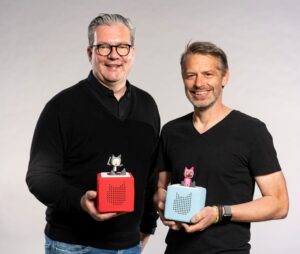
"Without a screen. But with a lot of imagination." The inventors of the Toniebox
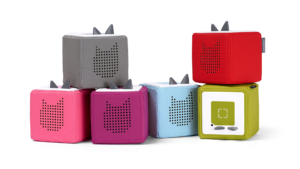 A starter set with a Toniebox, charging cable and Kreativ-Tonie costs €99.95 from the manufacturer; a remanufactured, used Toniebox with a two-year guarantee costs €59.00 and with accessories €74.97 Info at tonies.com
A starter set with a Toniebox, charging cable and Kreativ-Tonie costs €99.95 from the manufacturer; a remanufactured, used Toniebox with a two-year guarantee costs €59.00 and with accessories €74.97 Info at tonies.com
"The person you're talking to keeps on talking. You don't have time to think about it: you either understand it or you don't," explains Johann Reitmayer with conviction. His wife smiles: "With Michael, my husband understood Michelle for a long time..." You can move from one word list to the next by tapping on the side of the Toniebox. Only the order of the practice words within the lists cannot be varied. This was only possible last time, when practicing without the Toniebox - with live voice over the phone.

